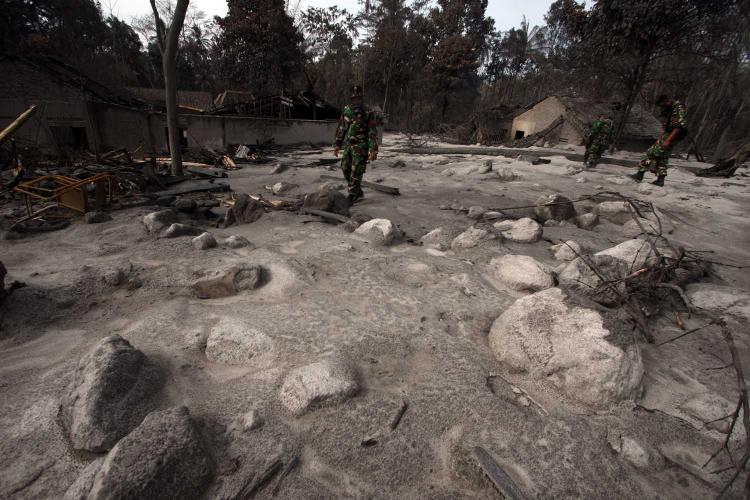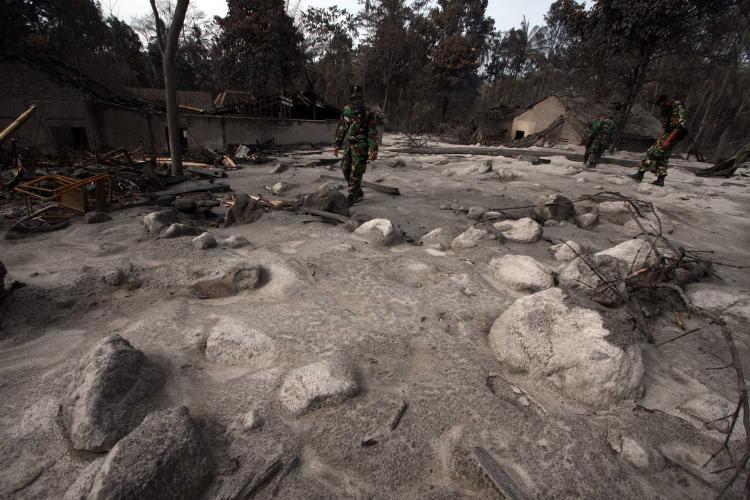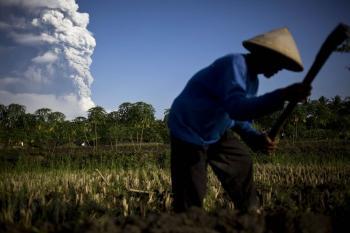KEPUHARJO, Indonesia—Several villages on the slopes of Mount Merapi have been utterly devastated by the volcano’s recent eruptions. One is Kepuharjo, near the Kali Gendol River, which has been almost completely destroyed by volcanic ash.
In some places, no trace of life remains. Villages such as Kali Adem, Jambu, Batur, Kopeng, Pagerjurang, and Nanggong, have been completely wiped out in the disaster.
As rescue teams and reporters pass through Kepuharjo, dead trees and animal carcasses stretch out before them.
Although four days have passed since the lava scorched the village, a large tree trunk is still burning. Meanwhile, cattle and other livestock are coated in a gray ash residue. Some are alive, but they are in poor condition.
A few villagers returned home to check on the damage, but none stayed for long. After a quick look, they immediately went back downhill, away from the volcano. Here in Kepuharjo, the rumblings of Merapi’s crater are still audible.
Villagers who want to go to Kali Gendol, four miles from Merapi, have to be extra cautious because Merapi’s summit is clouded over with gray ash and it is hard to tell if more hot ash eruptions occur, known locally as “wedhus gembel.”
The volcano’s activity was slowing on Tuesday morning, Nov. 9. However, lava is still flowing down along the Kali Gendol. Lava from the volcano has traveled 800 meters (875 yards) from Merapi, according to a report from the mitigation team.
A report from Ketep Observation Station stated that the rumbling sounds range from low to high intensities, with active flame and lava eruption from the crater. At 5.00 a.m. local time, Merapi released a volcanic cloud that reached 1.5 km (almost 1 mile) into the air.
In general, seismic activity, including hot volcanic ash and lava, is less than during the same period on Monday Nov. 8. Before 6.00 a.m. local time, there was one earthquake, three “low frequency” tremors, 20 eruptions of lava, and one hot-cloud eruption.
Like the hot ash cloud eruptions, lava is also a potential threat to life. Matter from the eruptions is building up along the river as the disaster continues.
Currently, Merapi’s activity is still classified at the highest level alert. Civilians must remain outside the 20-km (12-mile) exclusion zone.
To avoid danger, the government suggests villagers also keep away from rivers and streams near Merapi.
In some places, no trace of life remains. Villages such as Kali Adem, Jambu, Batur, Kopeng, Pagerjurang, and Nanggong, have been completely wiped out in the disaster.
As rescue teams and reporters pass through Kepuharjo, dead trees and animal carcasses stretch out before them.
Although four days have passed since the lava scorched the village, a large tree trunk is still burning. Meanwhile, cattle and other livestock are coated in a gray ash residue. Some are alive, but they are in poor condition.
A few villagers returned home to check on the damage, but none stayed for long. After a quick look, they immediately went back downhill, away from the volcano. Here in Kepuharjo, the rumblings of Merapi’s crater are still audible.
Villagers who want to go to Kali Gendol, four miles from Merapi, have to be extra cautious because Merapi’s summit is clouded over with gray ash and it is hard to tell if more hot ash eruptions occur, known locally as “wedhus gembel.”
The volcano’s activity was slowing on Tuesday morning, Nov. 9. However, lava is still flowing down along the Kali Gendol. Lava from the volcano has traveled 800 meters (875 yards) from Merapi, according to a report from the mitigation team.
A report from Ketep Observation Station stated that the rumbling sounds range from low to high intensities, with active flame and lava eruption from the crater. At 5.00 a.m. local time, Merapi released a volcanic cloud that reached 1.5 km (almost 1 mile) into the air.
In general, seismic activity, including hot volcanic ash and lava, is less than during the same period on Monday Nov. 8. Before 6.00 a.m. local time, there was one earthquake, three “low frequency” tremors, 20 eruptions of lava, and one hot-cloud eruption.
Like the hot ash cloud eruptions, lava is also a potential threat to life. Matter from the eruptions is building up along the river as the disaster continues.
Currently, Merapi’s activity is still classified at the highest level alert. Civilians must remain outside the 20-km (12-mile) exclusion zone.
To avoid danger, the government suggests villagers also keep away from rivers and streams near Merapi.




